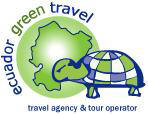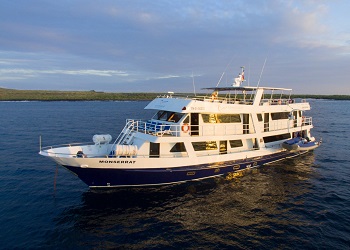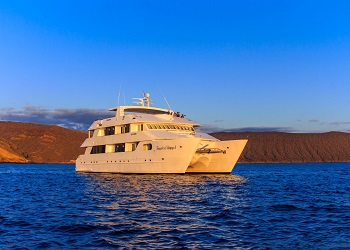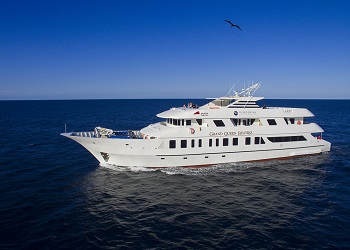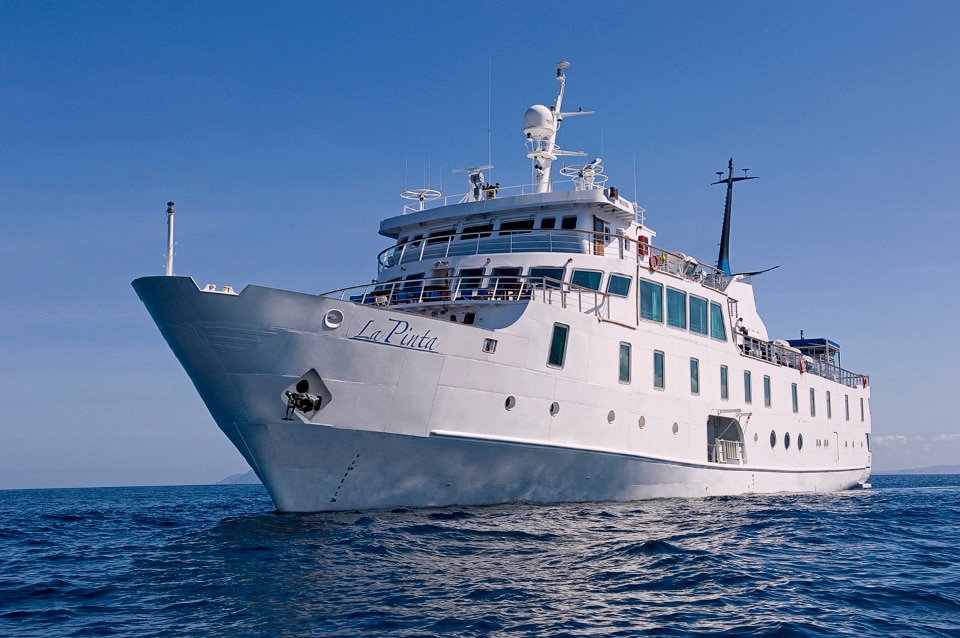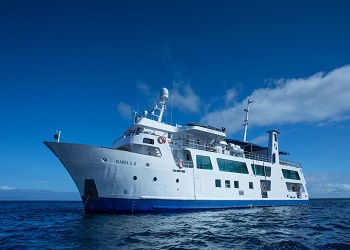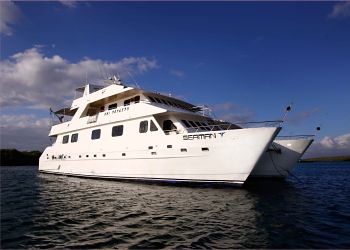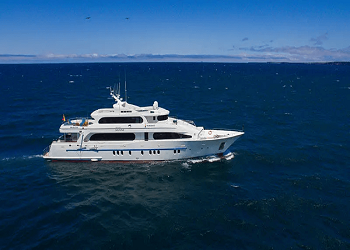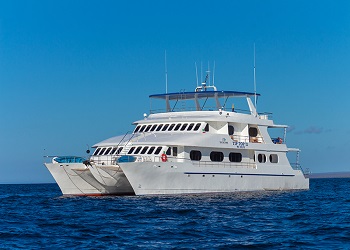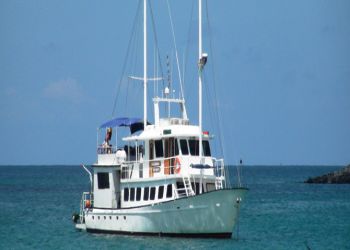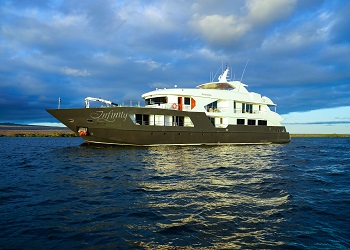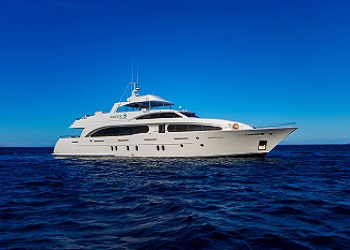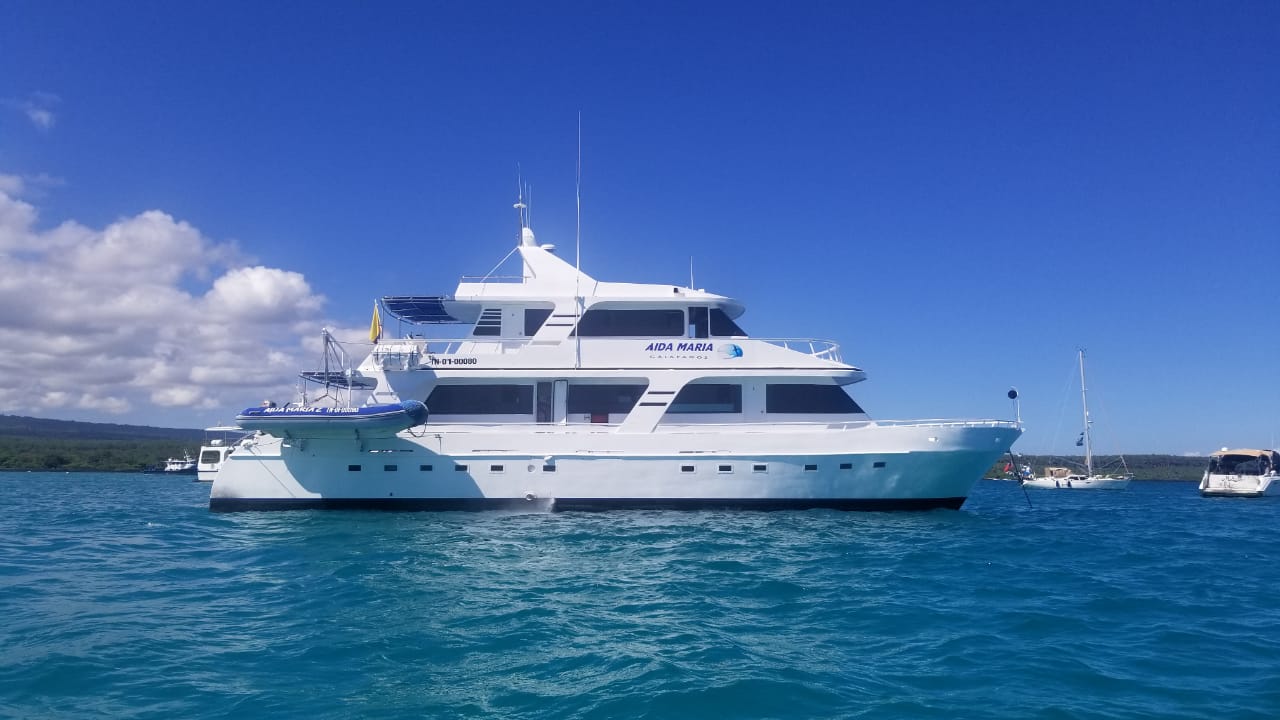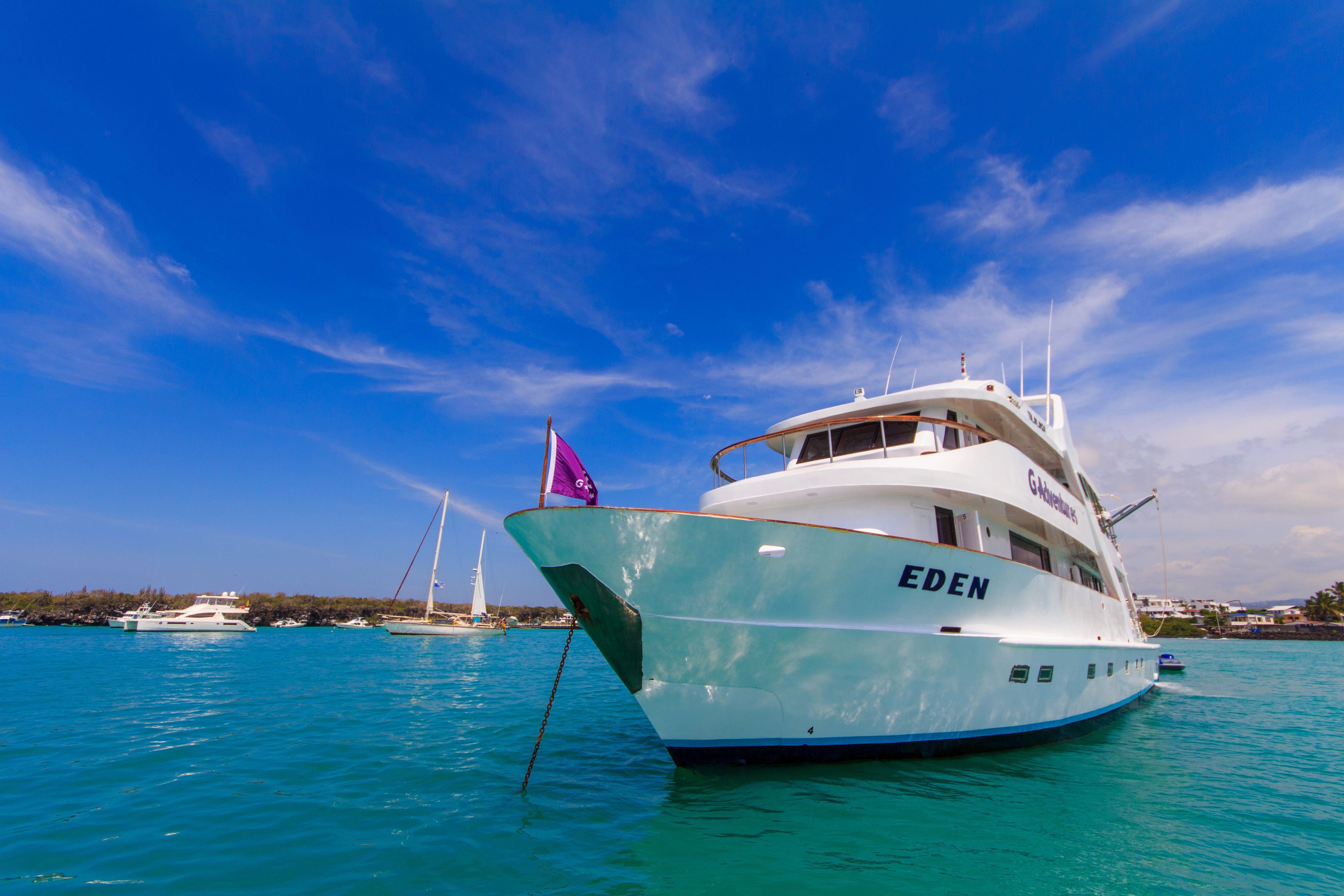ITINERARY B6, 6 days Sunday-Friday
1. Sunday: Baltra - Las Bachas
2. Monday: Mosquera - Cerro Dragon
3. Tuesday: Tagus Cove (Isabela) - Punta Espinoza (Fernandina)
4. Wednesday: Urbina Bay - Elizabeth Bay
5. Thursday: Punta Moreno - Navigation to Villamil with Whale Watching
1. Friday: Villamil - Puerto Ayora – Baltra OR
2. Excursion sierra Negra // end of services in Villamil at +/- 4:30 pm
First, some essential facts:
Your cruise journey starts at the airport of Quito or Guayaquil to take a flight. Galapagos is 1000 km from the continent, and visitors can only access it by plane.
To protect the island, you must pass through the special luggage control before going to the airline counter. You also must buy a visa, called TCT Card or INGALA, for 20* U$ in cash at the special counter at the departure airport. These procedures and the airline check-in need 2 ½ hours; we recommend not going to the airport later.
The flight from Quito to the Galapagos lasts 2.5 hours, with a stopover in Guayaquil. We base the yacht'soperation on flying the same day as the cruise starts at Baltra and back on the last day, also from Baltra. Of course, flying out before or remaining in Galapagos longer is possible.
Please, do not buy your ticket before ensuring that the arrival matches the cruise departure if you fly on the same Sunday as the cruise's start. We recommend buying them with Angelito's representatives to be on time and help us have an organized cruise start.
When arriving in Galapagos, the visitors must first pay the entrance fee of 100* U$ for the National Park. Then,after
picking the luggage up, Angelito's guide will be waiting for you at the exit of the arrival hall. We take a bus to the harbor of Baltra, where the Angelito anchors. The cruise can begin!
After the accommodation in your cabin and the lunch on board, we start our first visit!
DAY1: SUNDAY
BALTRA - LAS BACHAS
Baltra is a small island, the only Galapagos Island not included in the National Park's area. The Americans built Baltra's airport in 1941-1948, using it as their air force base in the Pacific during the Second World War. The airport and harbor are now Ecuadorian military territory. Unfortunately, both of the military presences have left their traces.
Even if we always speak about Baltra, the airport's official name is South Seymour, and its air code is GPS. With an essential reduction of energy consumption for lighting and ventilation, rainwater recovery, waste recycling, and more, the new building of 2013 has been promoted as the first ecological airport worldwide.
Las Bachas is a white coral beach in the north of the island of Santa Cruz and a genuinely lovely place to begin our tour. Our first visit starts with a wet landing. Wet landing means getting your feet wet while exiting the zodiac. Seawater and sand between the toes, what a feeling!
The walk along the beach is easy. There are small brackish water lagoons behind the dune where it is possible to observe coastal birds like black-necked stilts, whimbrels, white-cheeked pintail ducks, and, occasionally, flamingos.
Important: we take care and do not walk on top of the dunes because it is a favorite nesting site of sea turtles. After the walk, we can swim and enjoy the beach.

DAY2: MONDAY
MOSQUERA - CERRO DRAGON
Mosquera: This small sandy island between North Seymour and Baltra is home to one of the Galapagos' more significant sea lion colonies, with several harems. It is an excellent place to observe their behavior.
The wet landing can sometimes be a little difficult, depending on the tide.
We also may see endemic lava gulls and other coastal birds. We find marine iguanas and sally lightfoot crabs on the lava rocks and, sometimes, even scorpions under the stones.
First snorkeling activity of this week! Fantastic and recommendable, even if you never did it before. We include snorkel equipment in our cruise prices. If you need a wetsuit, you can rent it onboard.
Cerro Dragon: The name means Dragon Hill and is a very scenic visiting point. The hike passes first a flamingo lagoon behind the beach vegetation and leads through an impressive forest of prickly pear cacti. The following loop trail goes to a small hill where land iguanas live and nest. The view from this little peak over the surrounding landscape is spectacular.

DAY 3: TUESDAY
TAGUS COVE, ISABELA ISLAND - PUNTA ESPINOZA, FERNANDINA ISLAND
Tagus Cove: This protected cove was a favorite resting site of early pirates and whalers in the 19th century. They carved and painted their names on the high cliffs of the bay; it is emotive to see this historic testifies.
We start with a dry landing, and then the scenic hike leads uphill through the Dry zone vegetation to Darwin Lake, a saltwater crater lake. At the trail's end, we go up to a parasitic spatter cone and have a fantastic view of the Darwin Volcano's lava field.
Later, we enjoy a fantastic panga ride along the cliffs to look out for Galapagos penguins and flightless cormorants.
If the water is clear, Tagus Cove is a fascinating snorkeling place to discover many marine invertebrates in the vertical walls.
Punta Espinoza, Fernandina Island: This visit to one of the youngest islands of the Galapagos is undoubtedly a highlight of a cruise in the Galapagos. The terrain of Fernandina is rocky due to its volcanic nature. Depending on the tide, the dry landing is on the pier in the mangroves or directly on the lava.
On the hike in this pleasant marine environment of the Galapagos, we find large colonies of marine iguanas. We stay strict on the pathway because the dunes are their nesting areas.
On the lava coast, close to the shoreline, are the nesting places of the flightless cormorant, one of the most enigmatic Galapagos birds. Also, watch out for lava lizards, the Galapagos hawk, marine turtles, snakes, and the Galapagos penguins. And, obviously, more Galapagos sea lions.
We enjoy the largest groups of the endemic lava cacti that are to find on the lava flow. A short trail inland on a lava field leads to the edge of a large aa lava flow.
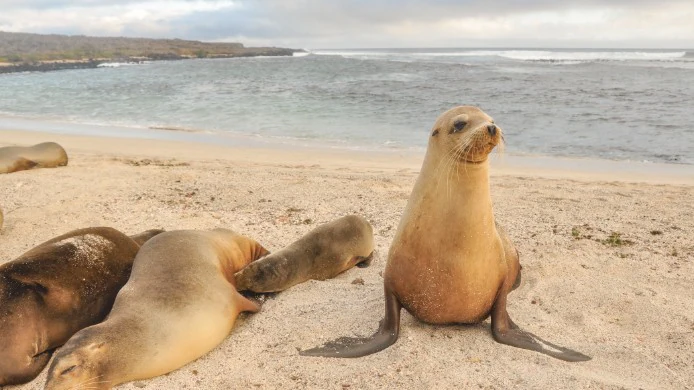
DAY4: WEDNESDAY
URBINA BAY - ELIZABETH BAY
Urbina Bay, Isabela Island: Another exclusive site! It is an area uplifted out of the sea at the foot of Volcan Alcedo.
The wet landing is on a steep beach, which is sometimes a bit difficult because of the high waves. But, with care, we do it.
Occasionally, we find flightless cormorants and huge marine iguanas along the shore. On the trail leading inland, we watch out to see the colorful land iguanas. If lucky, we cross with a Galapagos tortoise alongthe pathway! Then, we have time for snorkeling at this remarkable place.
Elizabeth Bay: This afternoon, we do not walk but drive with the zodiac into the protected mangrove cove. The entrance through a very narrow channel is not always easy, but our experienced crew manages it carefully, and so we find ourselves in the midden of this peaceful lagoon. In the small and far-away little corners, we turn the motoroff to noiselessly observe sea turtles.
In Elizabeth Bay, we find the tallest red mangrove trees of the Galapagos.

DAY 5. THURSDAY
PUNTA MORENO - NAVIGATION TO VILLAMIL WITH WHALE WATCHING
Punta Moreno: Early in the morning, we start a hike on Punta Moreno's rough lava field. It is a place where we can see all three cactus species: candelabra cactus, prickly pear cactus, and lava cactus. This lava field also has many pioneer plants.
The lava field turns out to be fantastic scenery, with oases with brackish water pools with flamingos, common gallinules, white-cheeked pintail ducks, and paint-billed crakes. We also may see the flightless cormorant. The Galapagos surprises never end!
Snorkeling at this great place is, once more, unique!
Navigation to Puerto Villamil: At approximately 10:30 in the morning, we start our longer navigation. It usually takes about 6 hours, and it is a beautiful part of our cruise along the shoreline around the Volcano Cerro Azul. Sometimes, this navigation may be rougher, but you can enjoy watching out for dolphin schools and whales on the sun deck. We hope to be lucky today too!
Just before the dark, we arrive in the small harbor of Puerto Villamil.
Villamil is the main settlement in the south of Isabela Island. The village has grown up in the last few years but is still small and calm with its scenic beaches and peaceful ambiance.

DAY 6: FRIDAY
For those passengers having booked the shortened option, ITINERARY B6, the cruise services can end in two alternatives: a) by traveling with the public speed boat at 6 am from Villamil to Puerto Ayora and, from there, to Baltra airport.
b) at 4:30 pm after the day's activities in Villamil:
Isabela Island, Villamil Sierra Negra - Tortoise Breeding Center
Sierra Negra: Today, we'll discover an absolutely different Galapagos! By bus, we go uphill, approximately 17 miles/27.3 km, to arrive close to the caldera of the Vulcan Sierra Negra. We can observe the changes in the different vegetation zones of the volcano. The Sierra Negra (Spanish: Black Mountain) is a massive shield volcano, and it is one of the most active in the Galapagos, with the most recent eruption in June 2018.
It is often a little bit rainy or misty and foggy, which is why it is so unexpectedly green here.

